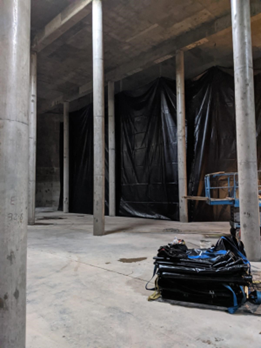Navigating Unexpected Contaminants with Your Geomembrane System
Part 3: Examples of Geomembranes Encountering Unexpected Contaminants
Unexpected contaminants coming in contact with an existing geomembrane system are real situations. In the final post of this series, three examples of situations that occurred will be presented, along with the project considerations and the outcome. In all three of these examples, the geomembrane did not require complete removal and replacement, but rather continued use was possible.
Example 1 - Application: Primary Containment, Collapsible Tank
Liquid contained: Pure commercial solution
Geomembrane: 8130 XR-5 Ethylene Copolymer
Background: Laboratory testing was conducted for 30 and 60 days, with total immersion utilizing exposed base fabric (industry standard) and it indicated good long-term compatibility. The liquid product cycled through all the units on a maximum 14-day pattern. After one year of service life, the facility owner expressed concern about one of the multiple units which was lined and contained the product. Operating conditions had changed and required that one unit hold stagnant fluid for what was now a year. Their knowledge of the product composition, which was confirmed by their testing, anticipated a chemical change in the liquid to a species unlike the original contained fluid.
Analysis and Solution: The newly created compounds were potentially an issue, depending on the concentration. So, the answer was either rotate the stored liquid more frequently to prevent creation of the potential reaction products or chemically prevent the creation of those products. While it required an operational change, the owner chose the first option, resulting in only low levels of the constituents of concern and no alternation of the product required.
Example 2 - Application: Impoundment Lining, Metal Fabrication Facility
Liquid contained: Site Runoff
Geomembrane: 8138 XR-5 Ethylene Copolymer
Background: A steel fabrication facility in the Midwest utilized a geomembrane to contain site runoff. Subsequently, after confirmation of acceptable content, the impounded runoff is released to surface water. A situation occurred where 9,000 gallons (34,000 L) of petroleum-based cutting oil was spilled within the watershed of the impoundment, outside of the protected unloading/storage area which had its own containment area. The geomembrane had been selected based on its resistance to metallic compounds, sunlight resistance, low thermal expansion contraction and high physical properties. Resistance to hydrocarbons was not a requirement. Because this volume of oil would accumulate at the water surface, damage to the geomembrane was a major concern.
Analysis and Solution: This is a situation where stratification of non-soluble, non-suspended or different polarity constituents, like many hydrocarbons, can result in what may be a low concentration overall, but be much higher when concentrated as non-aqueous phase liquids. At the water level, the geomembrane was subject to contact with 100% oil. Overall, 9,000 gallons (34,000 L) was a small portion of the entire impoundment, but how it existed in contact with the geomembrane was much different.
As it turns out, the geomembrane had excellent hydrocarbon resistance also. The manufacturer of the geomembrane was contacted through the owner’s consulting engineer and data was provided showing resistance to petroleum products of this type. In this situation, broad chemical resistance provided a margin of safety.
Example 3 - Application: Disinfection Chamber Diversion Baffles
Liquid contained: Potable Water
Geomembrane: 8130 XR-3 PW Ethylene Copolymer (NSF 61 Tested/approved Potable Water)
Background: A municipal potable water treatment plant employing Chlorine gas for post treatment disinfection was constructed with floating and suspended geomembrane diversion baffles in the contact chamber and clearwells, respectively. The specification called for a material with resistance up to 50 mg/l of free chlorine, anticipating a dosage rate never to exceed 10 mg/l. A brief plant mechanical failure resulted in a higher dosage being released, making the dosage rate at nearly 5,000 mgl/l. The brief event was corrected, and the higher dosage was managed through the clearwell and parts of the distribution system, with no customer consumption.
Analysis and Solution: The geomembrane was stated to be resistant to the specified Chlorine level, 50 mg/l, on a long term, continuous use basis. But in this event, it was exposed to a much higher level for several hours. The manufacturer was contacted and confirmed via previous testing that the geomembrane was in fact chemically resistant to at least 8% available chlorine. While Chlorine in elemental form is nonpolar, hypochlorous acid (formed from dissolution of chlorine in water at pH levels normally maintained for disinfection) is a weak acid and is polar. Given that the XR-5 geomembrane is also a polar material, it warrants further investigation. But with long term laboratory data produced by the manufacturer, the concentration at 0.5% was not an issue, although it is for some geomembrane products. The baffles and curtains continued in service after the event.

XR-3 PW Geomembrane Clearwell Curtains
California, USA
Think long term when selecting a geomembrane. Look for broad chemical resistance that has been proven. Read Part 1 and Part 2 of this blog series for additional information about navigating unexpected contaminants.



